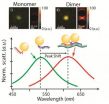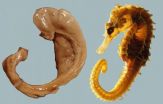(Press-News.org) Johns Hopkins scientists report that rats exposed to high-energy particles, simulating conditions astronauts would face on a long-term deep space mission, show lapses in attention and slower reaction times, even when the radiation exposure is in extremely low dose ranges.
The cognitive impairments — which affected a large subset, but far from all, of the animals — appear to be linked to protein changes in the brain, the scientists say. The findings, if found to hold true in humans, suggest it may be possible to develop a biological marker to predict sensitivity to radiation's effects on the human brain before deployment to deep space. The study, funded by NASA's National Space Biomedical Research Institute, is described in the April issue of the journal Radiation Research.
When astronauts are outside of the Earth's magnetic field, spaceships provide only limited shielding from radiation exposure, explains study leader Robert D. Hienz, Ph.D., an associate professor of behavioral biology at the Johns Hopkins University School of Medicine. If they take space walks or work outside their vehicles, they will be exposed to the full effects of radiation from solar flares and intergalactic cosmic rays, he says, and since neither the moon nor Mars have a planet-wide magnetic field, astronauts will be exposed to relatively high radiation levels, even when they land on these surfaces.
But not everyone will be affected the same way, his experiments suggest. "In our radiated rats, we found that 40 to 45 percent had these attention-related deficits, while the rest were seemingly unaffected," Hienz says. "If the same proves true in humans and we can identify those more susceptible to radiation's effects before they are harmfully exposed, we may be able to mitigate the damage."
If a biomarker can be identified for humans, it could have even broader implications in determining the best course of treatment for patients receiving radiotherapy for brain tumors or identifying which patients may be more at risk from radiation-based medical treatments, the investigators note.
Previous research has tested how well radiation-exposed rats do with basic learning tasks and mazes, but this new Johns Hopkins study focused on tests that closely mimic the self-tests of fitness for duty currently used by astronauts on the International Space Station prior to mission-critical events such as space walks. Similar fitness tests are also used for soldiers, airline pilots and long-haul truckers.
In one such test, an astronaut sees a blank screen on a handheld device and is instructed to tap the screen when an LED counter lights up. The normal reaction time should be less than 300 milliseconds. The rats in the experiment are similarly taught to touch a light-up key with their noses and are then tested to see how quickly they react.
To conduct the new study, rats were first trained for the tests and then taken to Brookhaven National Laboratory on Long Island in Upton, N.Y., where a collider produces the high-energy proton and heavy ion radiation particles that normally occur in space. The rats' heads were exposed to varying levels of radiation that astronauts would normally receive during long-duration missions, while other rats were given sham exposures.
Once the rats returned to Johns Hopkins, they were tested every day for 250 days. The radiation-sensitive animals (19 of 46) all showed evidence of impairment that began at 50 to 60 days post–exposure and remained through the end of the study.
Lapses in attention occurred in 64 percent of the sensitive animals, elevations in impulsive responding occurred in 45 percent and slower reaction times occurred in 27 percent. The impairments were not dependent on radiation dose. Additionally, some of the rats didn't recover at all from their deficits over time, while others showed some recovery over time.
The radiation-sensitive rats that received higher doses of radiation had a higher concentration of transporters for the neurotransmitter dopamine, which plays a role in vigilance and attention, says Catherine M. Davis, Ph.D., a postdoctoral fellow in the Department of Psychiatry and Behavioral Sciences and the study's first author.
The dopamine transport system appears impaired in radiation-sensitive rats because the neurotransmitter is most likely not removed in the manner it should be for the brain to function properly, she says. Humans with genetic differences related to dopamine transport, she adds, have been shown to do worse on the type of mental fitness tests given to the astronauts and rats alike.
Davis says she wouldn't want to see radiation-sensitive astronauts kept from future missions to the moon or Mars, but she would want those astronauts to be prepared to take special precautions to protect their brains, such as wearing extra shielding or not performing space walks.
"As with other areas of personalized medicine, we would seek to create individual treatment and prevention plans for astronauts we believe would be more susceptible to cognitive deficits from radiation exposure," she says.
Current astronauts are not as exposed to the damaging effects of radiation, Davis says, because the International Space Station flies in an orbit low enough that the Earth's magnetic field continues to provide protection.
While the Johns Hopkins team studies the likely effects of radiation on the brain during a deep space mission, other NASA-funded research groups are looking at the potential effects of radiation on other parts of the body and on whether it increases cancer risks.
INFORMATION:
Peter G. Roma, Ph.D., of Johns Hopkins, and Kathleen L. DeCicco-Skinner, Ph.D., of American University in Washington, DC, also contributed to this research.
Johns Hopkins Medicine (JHM), headquartered in Baltimore, Maryland, is a $6.7 billion integrated global health enterprise and one of the leading health care systems in the United States. JHM unites physicians and scientists of the Johns Hopkins University School of Medicine with the organizations, health professionals and facilities of The Johns Hopkins Hospital and Health System. JHM's vision, "Together, we will deliver the promise of medicine," is supported by its mission to improve the health of the community and the world by setting the standard of excellence in medical education, research and clinical care. Diverse and inclusive, JHM educates medical students, scientists, health care professionals and the public; conducts biomedical research; and provides patient-centered medicine to prevent, diagnose and treat human illness. JHM operates six academic and community hospitals, four suburban health care and surgery centers, and more than 30 primary health care outpatient sites. The Johns Hopkins Hospital, opened in 1889, was ranked number one in the nation for 21 years in a row by U.S. News & World Report.
Johns Hopkins Medicine
Media Relations and Public Affairs
Media Contacts:
Stephanie Desmon
410-955-8665; sdesmon1@jhmi.edu
Lauren Nelson
410-955-8725; lnelso35@jhmi.edu END
Some astronauts at risk for cognitive impairment, animal studies suggest
Damage traced in part to dopamine transport system injury in brain cells
2014-04-23
ELSE PRESS RELEASES FROM THIS DATE:
Gold nanoparticles help target, quantify breast cancer segments in a living cell
2014-04-23
WEST LAFAYETTE, Ind. - Purdue University researchers have developed a way to detect and measure cancer levels in a living cell by using tiny gold particles with tails of synthetic DNA.
A team led by Joseph Irudayaraj, professor of agricultural and biological engineering, used gold nanoparticles to target and bind to fragments of genetic material known as BRCA1 messenger RNA splice variants, which can indicate the presence and stage of breast cancer. The number of these mRNA splice variants in a cell can be determined by examining the specific signal that light produces ...
Study identifies enzymes that help fix cancer-causing DNA defects
2014-04-23
Purdue University researchers have identified an important enzyme pathway that helps prevent new cells from receiving too many or too few chromosomes, a condition that has been directly linked to cancer and other diseases.
Mark Hall, associate professor of biochemistry, found that near the end of cell division, the enzyme Cdc14 activates Yen1, an enzyme that ensures any breaks in DNA are fully repaired before the parent cell distributes copies of the genome to daughter cells. This process helps safeguard against some of the most devastating genome errors, including the ...
A key to enjoying massive online photo files may be giving up some control
2014-04-23
PITTSBURGH—The ability of individuals to store and instantly access thousands of their photos online has become a commonplace luxury, but the sheer size of these archives can be intimidating. Researchers at Carnegie Mellon University and Microsoft Research Cambridge, UK, have found people might actually enjoy their collections more by giving up a bit of control and learning to wait.
Their 14-month study showed that people reflected more on past events and developed a renewed interest in their online photos when a device called Photobox would randomly print four or five ...
AGU: Odds of storm waters overflowing Manhattan seawall up 20-fold, new study shows
2014-04-23
WASHINGTON, D.C. -- Maximum water levels in New York harbor during major storms have risen by nearly two and a half feet since the mid-1800s, making the chances of water overtopping the Manhattan seawall now at least 20 times greater than they were 170 years ago, according to a new study. Whereas sea-level rise, which is occurring globally, has raised water levels along New York harbor by nearly a foot and a half since the mid-19th century, the research shows that the maximum height of the city's "once-in-10-years" storm tide has grown additionally by almost a foot in that ...
Study finds long-term survival of human neural stem cells transplanted into primate brain
2014-04-23
Putnam Valley, NY. (Apr. 23 2014) – A team of researchers in Korea who transplanted human neural stem cells (hNSCs) into the brains of nonhuman primates and assessed cell survival and differentiation after 22 and 24 months found that the hNSCs had differentiated into neurons at 24 months and did not cause tumors.
The study will be published in a future issue of Cell Transplantation but is currently freely available on-line as an unedited early e-pub at: http://www.ingentaconnect.com/content/cog/ct/pre-prints/content-ct1117Antonucci2.
The hNSCs were labeled with magnetic ...
Scientists identify source of mysterious sound in the Southern Ocean
2014-04-23
Scientists have conclusive evidence that the source of a unique rhythmic sound, recorded for decades in the Southern Ocean and called the "bio-duck," is the Antarctic minke whale (Balaenoptera bonaerensis). First described and named by submarine personnel in the 1960s who thought it sounded like a duck, the bio-duck sound has been recorded at various locations in the Southern Ocean, but its source has remained a mystery, until now.
In February 2013, an international team of researchers deployed acoustic tags on two Antarctic minke whales in Wilhelmina Bay off the western ...
Autologous stem cell therapy improves motor function in chronic stroke victims
2014-04-23
Putnam Valley, NY. (Apr. 23, 2014) – People who have had a stroke, often suffer motor deficits with little potential to restore neurological function. However, a study conducted in Taiwan, that will be published in a future issue of Cell Transplantation, but is currently freely available on-line as an unedited early e-pub at: http://www.ingentaconnect.com/content/cog/ct/pre-prints/content-ct1168Chen, has found that when one group of stroke victims had their own peripheral blood stem cells (PBSCs) injected directly into the brain and a similar group did not, those who received ...
Too many chefs: Smaller groups exhibit more accurate decision-making
2014-04-23
The trope that the likelihood of an accurate group decision increases with the abundance of brains involved might not hold up when a collective faces a variety of factors — as often happens in life and nature. Instead, Princeton University researchers report that smaller groups actually tend to make more accurate decisions while larger assemblies may become excessively focused on only certain pieces of information.
The findings present a significant caveat to what is known about collective intelligence, or the "wisdom of crowds," wherein individual observations — even ...
Community-based weight loss program aids diabetes management
2014-04-23
Weight loss and control of blood sugar can reduce the risk of complications in patients with diabetes but this is difficult for many to achieve. A University of California, San Diego School of Medicine randomized controlled trial of obese adults with type 2 diabetes suggests that participants enrolled in a community-based structured weight loss program are able to shed more pounds, improve blood sugar control and reduce or eliminate insulin use and other medications compared to a control group.
"Support and a tailored lifestyle intervention have been shown to reduce cardiovascular ...
Physical activity keeps hippocampus healthy in people at risk for Alzheimer's disease
2014-04-23
COLLEGE PARK, Md. – A study of older adults at increased risk for Alzheimer's disease shows that moderate physical activity may protect brain health and stave off shrinkage of the hippocampus– the brain region responsible for memory and spatial orientation that is attacked first in Alzheimer's disease. Dr. J. Carson Smith, a kinesiology researcher in the University of Maryland School of Public Health who conducted the study, says that while all of us will lose some brain volume as we age, those with an increased genetic risk for Alzheimer's disease typically show greater ...
LAST 30 PRESS RELEASES:
Making lighter work of calculating fluid and heat flow
Normalizing blood sugar can halve heart attack risk
Lowering blood sugar cuts heart attack risk in people with prediabetes
Study links genetic variants to risk of blinding eye disease in premature infants
Non-opioid ‘pain sponge’ therapy halts cartilage degeneration and relieves chronic pain
AI can pick up cultural values by mimicking how kids learn
China’s ecological redlines offer fast track to 30 x 30 global conservation goal
Invisible indoor threats: emerging household contaminants and their growing risks to human health
Adding antibody treatment to chemo boosts outcomes for children with rare cancer
Germline pathogenic variants among women without a history of breast cancer
Tanning beds triple melanoma risk, potentially causing broad DNA damage
Unique bond identified as key to viral infection speed
Indoor tanning makes youthful skin much older on a genetic level
Mouse model sheds new light on the causes and potential solutions to human GI problems linked to muscular dystrophy
The Journal of Nuclear Medicine ahead-of-print tip sheet: December 12, 2025
Smarter tools for peering into the microscopic world
Applications open for funding to conduct research in the Kinsey Institute archives
Global measure underestimates the severity of food insecurity
Child survivors of critical illness are missing out on timely follow up care
Risk-based vs annual breast cancer screening / the WISDOM randomized clinical trial
University of Toronto launches Electric Vehicle Innovation Ontario to accelerate advanced EV technologies and build Canada’s innovation advantage
Early relapse predicts poor outcomes in aggressive blood cancer
American College of Lifestyle Medicine applauds two CMS models aligned with lifestyle medicine practice and reimbursement
Clinical trial finds cannabis use not a barrier to quitting nicotine vaping
Supplemental nutrition assistance program policies and food insecurity
Switching immune cells to “night mode” could limit damage after a heart attack, study suggests
URI-based Global RIghts Project report spotlights continued troubling trends in worldwide inhumane treatment
Neutrophils are less aggressive at night, explaining why nighttime heart attacks cause less damage than daytime events
Menopausal hormone therapy may not pose breast cancer risk for women with BRCA mutations
Mobile health tool may improve quality of life for adolescent and young adult breast cancer survivors
[Press-News.org] Some astronauts at risk for cognitive impairment, animal studies suggestDamage traced in part to dopamine transport system injury in brain cells




